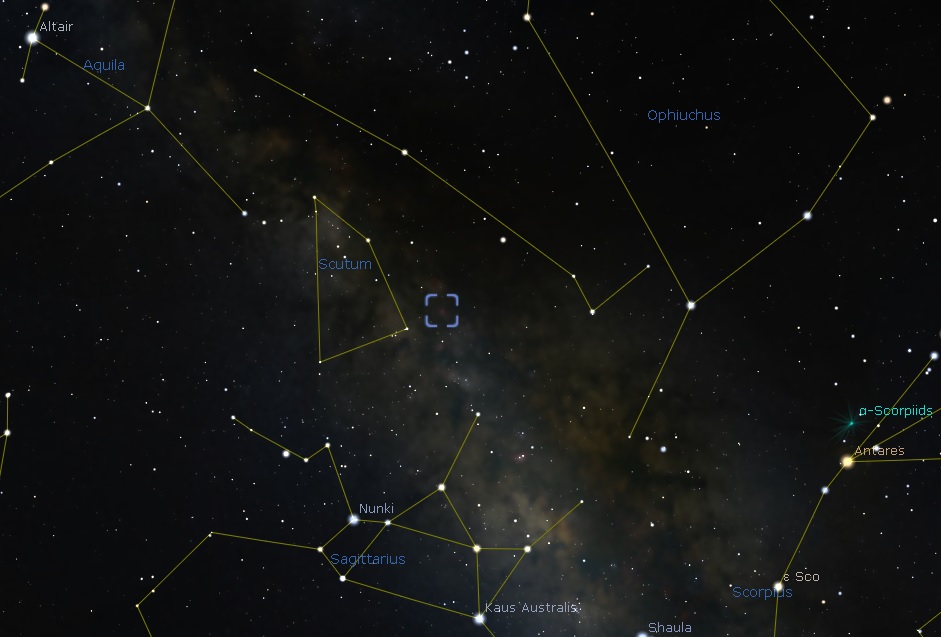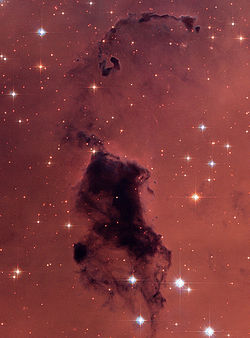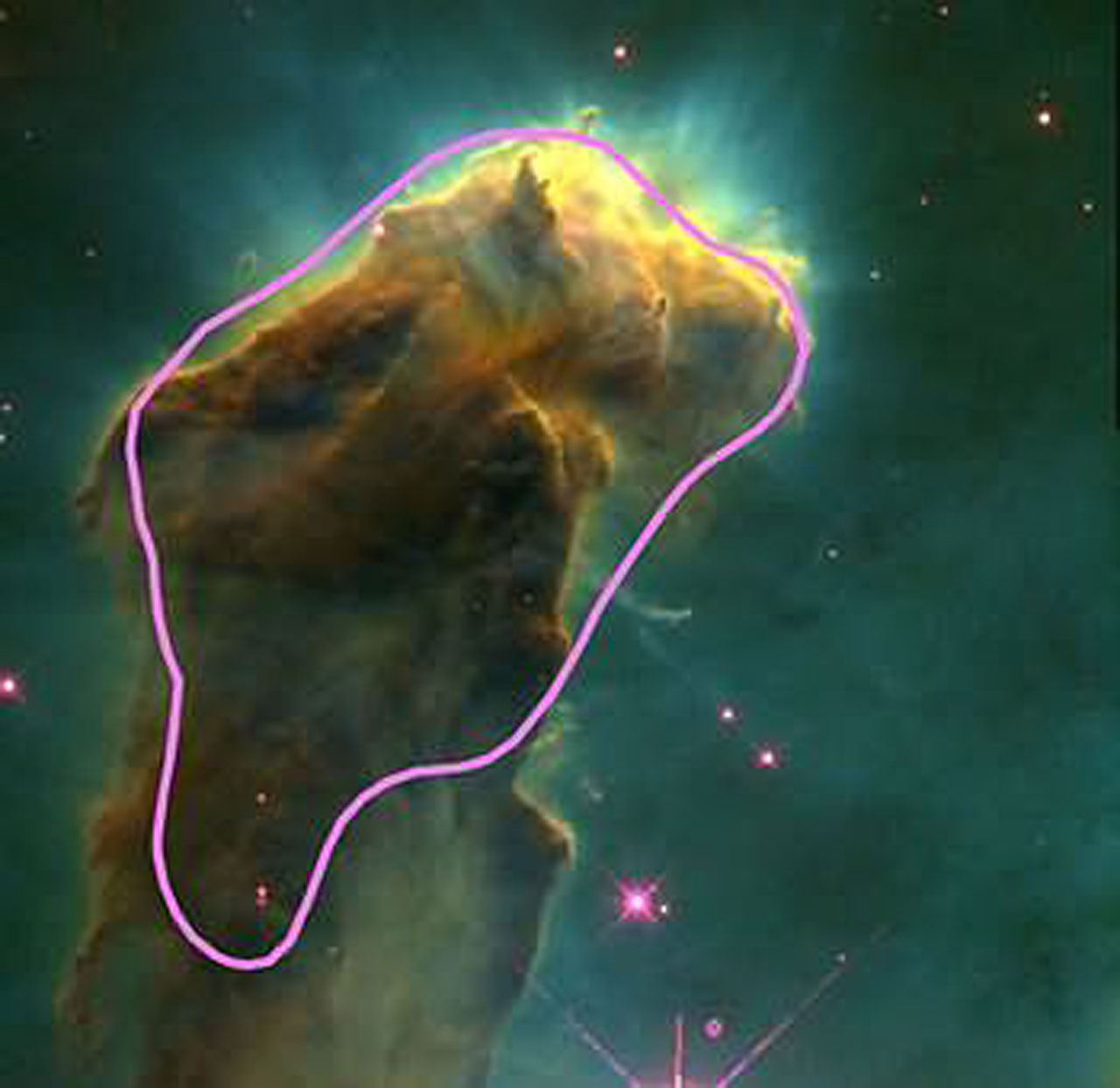
Meet the Pillars of Creation, a photograph taken by the Hubble Telescope in 1995. These apparent “pillars” of dust and gas are what we call molecular clouds. And this region of clouds in space is aptly named: it’s where stars are created.
Technically, there are two types of molecular clouds—molecular clouds and giant molecular clouds, or GMCs—but I’ll get into that in a second.
Molecular clouds are deep within the interstellar medium. In case you don’t remember the ISM from my “recent” posts (sorry about that), it’s the stuff between the stars. It’s the galaxy’s backstage. Space is in fact not a perfect vacuum—it’s full of the ISM.
So what’s going on with molecular clouds like the Pillars of Creation?
This particular group of molecular clouds is deep within the Eagle Nebula, also known as M16 and found inside the constellation Serpens. In case you don’t know where that is, it’s in the brilliantly dense region of the Milky Way near Sagittarius.

By the way, there are a lot of really incredible telescopic objects in this area—the Swan, Trifid, and Lagoon Nebulae, to name a few. M6 and M7—the Ptolemy and Butterfly clusters—are also relatively nearby, in Scorpius’s stinger. But I’ll come back to those in later posts.
We’ll also come back to actual star formation in a later post. Sorry…but I’ll get to it soon! For now, I want to focus on the molecular clouds themselves.
So, want to venture a guess at why they’re named that?
Okay, I’ll admit it, that was an easy one…yes, they have molecules. But that’s special because other clouds in the interstellar medium—the cool clouds, the intercloud medium, and the coronal gas (which will be my next post)—don’t have molecules.
Why? They’re not dense enough.
Molecules require specific conditions in order to form, and those conditions are rare in space. More delicate substances require the protection of a planetary atmosphere. But for planets to form in the first place, we need a place that’s protected from the harsh conditions we find in space.
Just one ultraviolet photon passing by from a distant star is enough to break a fragile molecule apart. If a cloud is too hot, it means its particles are moving too fast for them to stick together and form molecules. And if a cloud isn’t dense enough, particles won’t find each other to stick together—they’ll be too far apart.
Cool clouds are, as you can guess, cool—but they’re not dense. The intercloud medium is even less dense, and extremely hot for a region of space with no hydrogen fusion happening. And coronal gas is, similarly, very hot and with a low density. So it’s unlikely we’ll get any molecules forming there.
That leaves us with molecular clouds…and there’s a reason the Pillars of Creation look like thick plumes of smoke. They are dense—enough to be opaque. They are cool—enough to be dark. In fact, they’re only a few degrees above absolute zero.
And their density has an extra bonus: the material deep inside is shielded from the ravages of space, allowing molecules to form.
So what’s the difference between a plain old molecular cloud and a giant molecular cloud?

Hey, remember Barnard 68, the “Black Cloud,” from a recent post of mine? It’s one such “plain ol'” molecular cloud, also known as a Bok globule.
Here’s a prettier one:

Note that this globule, located within the NGC 281 nebula, is no different from the “Black Cloud” above. They’re the same type of cloud, made of the same type of stuff, of roughly the same size and probably similar mass.
What makes them different is that this cloud is silhouetted in front of a pretty pink emission nebula, whereas the “Black Cloud” only has the stars behind it to silhouette it—making it look more like a hole in space than a physical object.
These Bok globules are small, containing only the mass of one of their larger counterparts’ dense cores. They’re only about 50 solar masses (50 times the mass of our sun), pretty small for an interstellar cloud.
On the other hand, I’ve already shown you an example of a giant molecular cloud—the Pillars of Creation above.

But if you thought the pillars themselves were huge…well, you’ve got no idea. Let me show you just how massive these clouds are…
So. The Earth is about 5.972 × 1024 kg. That’s 5,972,000,000,000,000,000,000,000 kg, which is about 3,981,333,333,000,000,000,000 times the mass of your average car. The sun, on the other hand, is about 1.9891 × 1030 kg— that’s 333,071 times the mass of the Earth.
Your small molecular clouds are about fifty to a few hundred times that—no less than 9.9485 × 1031 kg. So how do you think that compares to the mass of all three pillars of creation?
I’ll tell you. That’s just the mass of this little circled region here.

In case you’re not sure where that is, that’s the glob of dust at the very top of the far left pillar.
Yeah. That tiny little glob is about fifty to a few hundred times the mass of the sun. That’s pretty darn big.
Giant molecular clouds, or GMCs, can contain up to a million solar masses—a million suns like ours reduced to gas and dust and mixed up into a cocktail of solar system-forming material. They’re huge.
So, speaking of suns…what are these GMCs made of, anyway?
Well, that’s actually a pretty easy question to answer—same thing the rest of the universe is made out of. Something you’ll find as you study the universe is that the balance of materials is pretty much the same wherever you go. The difference is just how hot it’s cooked up, how dense it is, how much of it there is.
The universe is predominantly full of hydrogen with a bit of helium, and a tiny, tiny amount of all the heavier elements. And the same goes for GMCs.
GMCs are mainly hydrogen—about 70%—and are about 28% helium. Only 2% of the material in a GMC is carbon, oxygen, nitrogen, or any of the other elements you encounter in your daily life.
Thanks to the conditions found within molecular clouds, those remaining elements can actually combine into molecules. One such molecule is CO, or carbon monoxide. You may know that carbon monoxide is harmful to humans, but it’s critical to a molecular cloud.
Carbon monoxide is very good at radiating infrared radiation (a fancy term for heat), and plays the role of a thermostat, dispelling any heat that manages to build up. Thus, the cloud manages to stay cool.
Now, stars don’t form from molecular clouds because they’re cool. Their temperature and density help form molecules, but all they need for star formation is their high density and high mass…and we’ll dive deeper into that very soon.
Are the molecular clouds remnants of earlier stars ? I thought elements heavier than hydrogen required star fusion.
LikeLiked by 1 person
Yes! 🙂 Specifically, their material was all once inside stars. Any one cloud can’t trace its origins back to a specific star or group of stars. It’s like an interstellar soup of “star stuff,” ejected from past supernovae. (Read more on supernovae here.) You might be interested in a more recent post of mine on the composition of our own Milky Way Galaxy, where I actually do cover the broader “life cycle” of stars in which the material from past “generations” is mixed back into the interstellar medium to create future stellar nurseries. (Find it here.)
LikeLike
Fascinating… ‘Preciate how you explain info that is difficult to grasp.
LikeLiked by 1 person
Glad I could help!
LikeLiked by 1 person